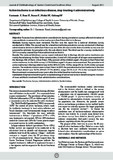| dc.contributor.author | Karimurio, J | |
| dc.contributor.author | Rono, H | |
| dc.contributor.author | Barasa, E | |
| dc.contributor.author | Mukiri, M | |
| dc.contributor.author | Gichangi, M | |
| dc.date.accessioned | 2014-02-24T07:46:08Z | |
| dc.date.available | 2014-02-24T07:46:08Z | |
| dc.date.issued | 2013 | |
| dc.identifier.citation | Journal of Ophthalmology of Eastern, Central and South Africa Vol 17, No 1 (2013) | en_US |
| dc.identifier.uri | http://www.coecsa.org/ojs-2.4.2/index.php/JOECSA/article/view/68 | |
| dc.identifier.uri | http://hdl.handle.net/11295/64851 | |
| dc.description.abstract | Objective: To assess how administrative considerations during prevalence surveys affected initiation of mass antibiotic treatment for active trachoma in East Pokot district in Kenya.
Methods: Survey reports were reviewed. The first was the report for a national blindness survey conducted in 1980s. The second was for a baseline trachoma prevalence survey conducted in Baringo administrative district in 2004. East Pokot was one of the divisions in the district and the survey was not powered to estimate the prevalence for the sub-district level. The third was for a survey conducted in 2011 in a newly created East Pokot administrative district.
Results: The national blindness survey report indicated that in Baringo district active trachoma was mainly found among the East Pokot communities. A total of 1,182 people of all ages were examined in
the Baringo; 596 of them in East Pokot. Fifty percent of the children aged <10 years in East Pokot had active trachoma. In the 2004 survey 1,179 children aged 1-9 years were examined. The prevalence of active trachoma in Baringo district was 6.4%( 95% CI: 3.9% - 9.9%), range 0% to 33.3% in the surveyed clusters. The endemic clusters were in East Pokot. In 2011 the prevalence of active trachoma in the new East Pokot district was 34.3% (95%CI: 27.7%-40.8%), range 28.1% to 41.7% in the surveyed clusters.
Mass treatment commenced seven years after the initial baseline trachoma survey.
Conclusion: Emphasis should be given to epidemiology of active trachoma in determining the initiation of mass antibiotic treatment than administrative considerations. | en_US |
| dc.language.iso | en | en_US |
| dc.publisher | College of Health sciences | en_US |
| dc.title | Active trachoma is an infectious disease, stop treating it administratively | en_US |
| dc.type | Article | en_US |


